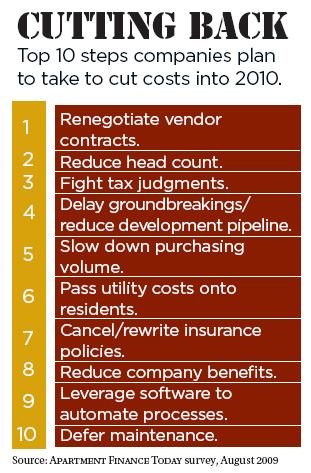“We will continue to implement job sharing across the company. It was successful throughout 2009 in terms of saving costs on payroll and the hiring process,” Pittro says. “Job sharing is not difficult in a company of our size with 20 sites, and the ability for employees to be cross-functional on the management and development side—or at least have exposure to our different business units—creates more efficient communication that enables us to move quickly when opportunities arise.”
Likewise, The Connor Group isn’t set to be a heavy recruiter in 2010, despite the expectation of a critical mass of qualified and even over-qualified applicants in the multifamily job pool. “Instead, we’re increasing our internal training budget this year by $400,000,” Connor says. “We continue to believe it’s who you’ve got, not how many people you’ve got.”
15. Figure Out Facebook.
The Bozzuto Group’s strategy of relying on a youth movement to assist in the Bozzuto social media marketing effort is evidence of the larger multifamily question mark still hanging over community networking sites such as Facebook, MySpace, and Twitter. While such sites represent vast pools of rental prospects, tapping into the reservoir, especially from a sales and marketing standpoint, remains a challenge.
“We’ve not seen a lot of traction out on Facebook or Twitter or the Wikis in terms of ‘Gosh I want to do business,’” UDR’s Toomey says. “It’s really an arena to socialize. The transactional aspect of it has not been developed.”
To that point, Camden has made an undisclosed investment in rentwiki.com, a social media Web site with an underlying lead generation Internet listing service in the system architecture. “We were impressed with their technology but also with the knowledge of the social media marketing,” CEO Campo says. “Everyone is trying to figure out what you do and how you do it and how you target the 18 to 25 demographic using Facebook and Twitter. We are spending a fair amount of time and money making sure we are state-of-the-art in that regard.”
16. Invest in Technology.
Elsewhere on the technology front, multifamily corporate leaders anticipate diverting dollars back into tech budgets after roughly two years of cuts. At UDR, Toomey anticipates keeping technology appropriations at full-throttle as his peer groups return to making infrastructure investments. “In a period when people have been pulling in their horns, we have been accelerating,” Toomey says. “Will that continue? Well, no one ever remembers second—you have to be first in this platform.” In particular, UDR looks to continue adapting its tech platform in anticipation of the eventual cob-webbing of desktop PCs in favor of mobile computing. “Our targeted renter, between 20 and 35, is adopting the mobile device as the primary communication tool,” Toomey says.
Likewise, Camden is looking at mobile applications for viewing apartment info and availability, completing leases, or even paying rent via cell phone, Campo says. “2010 will be characterized by more investment and focus in technology rather than less,” Campo says, adding that Camden will also look to bolster the tech footprint of the leasing office by introducing leasing kiosks at on-site locations.
That type of on-site, resident-facing technology will continue to be vital as multifamily operators compete for both tech-hungry Gen Y residents as well as older prospects who have come to expect lifestyle efficiencies and bell-and-whistle upgrades to the rental lifestyle. “Technology is the one spot that will not be part of a value engineering exercise in 2010,” says Lomenick of High Street Residential. “There is a lot of cost and effort in creating leading-edge communities, especially in development. Technology and your health club are the two most important things you can do, and if that means you can’t do solar panels on your roof, then the solar goes first.”
RENTS AND RENEWALS
17. Push Rents Wherever You Can.
File it under wishful thinking if you will, but 2010 could present some operators in certain submarkets the opportunity to begin to push rent levels incrementally higher, particularly towards the end of the year. “We’re not forecasting rent growth for 2010,” says ZOM’s Patterson, “but that doesn’t mean we’re not going to try.”
 According to Nadji of Marcus & Milli-chap, the obvious contributing factor to rent improvement is a reversal in job creation. “Given the realities of the marketplace, rents are going to be under pressure through 2010, but I’m more optimistic than some that job creation could return stronger than expected on the upside of the recovery.”
According to Nadji of Marcus & Milli-chap, the obvious contributing factor to rent improvement is a reversal in job creation. “Given the realities of the marketplace, rents are going to be under pressure through 2010, but I’m more optimistic than some that job creation could return stronger than expected on the upside of the recovery.”
Profiting from a swing in job creation will likely come at the submarket level, and Western National plans to keep the focus on its home turf as it relates to pushing rent levels to new prospects. “There’s no magic potion to increasing rents or putting more money in the bank—you’ve just got to be better, more creative, and more aggressive than the next guy,” Shelton says. “We’ll stay honed in on our submarkets and rely on our regional scale. We have an advantage there.”
